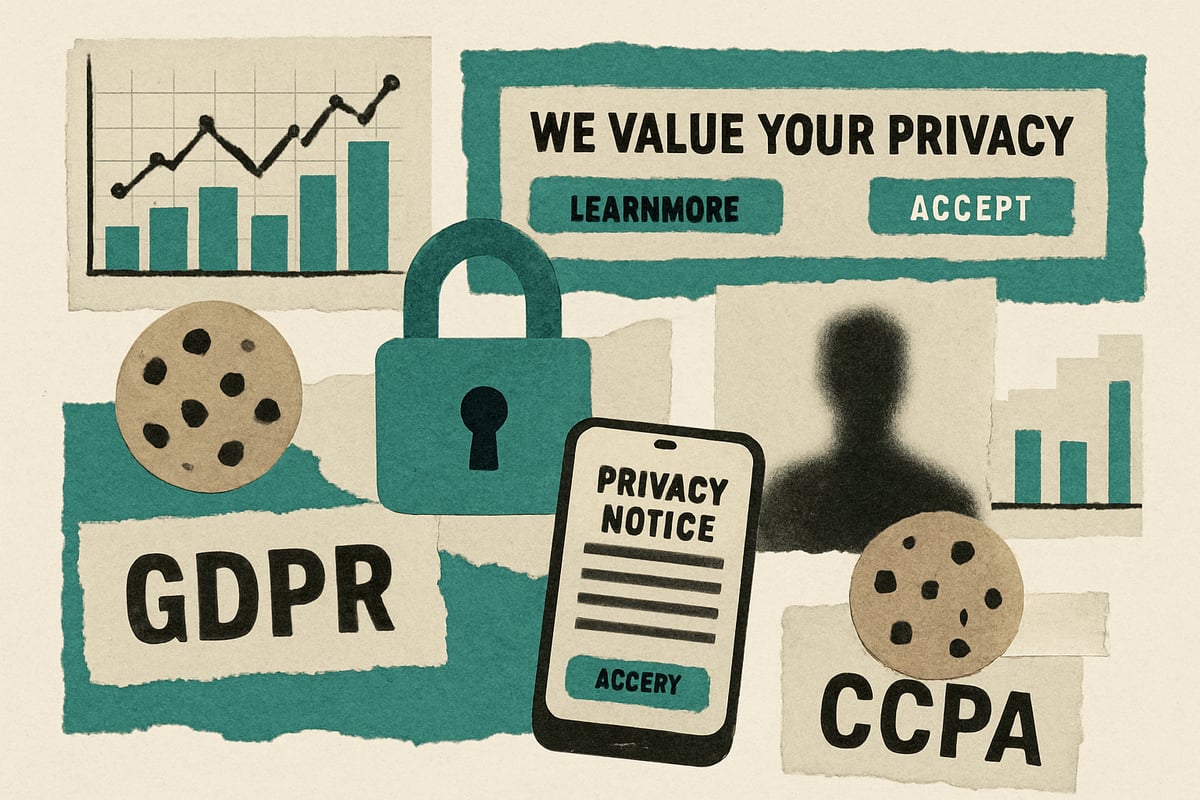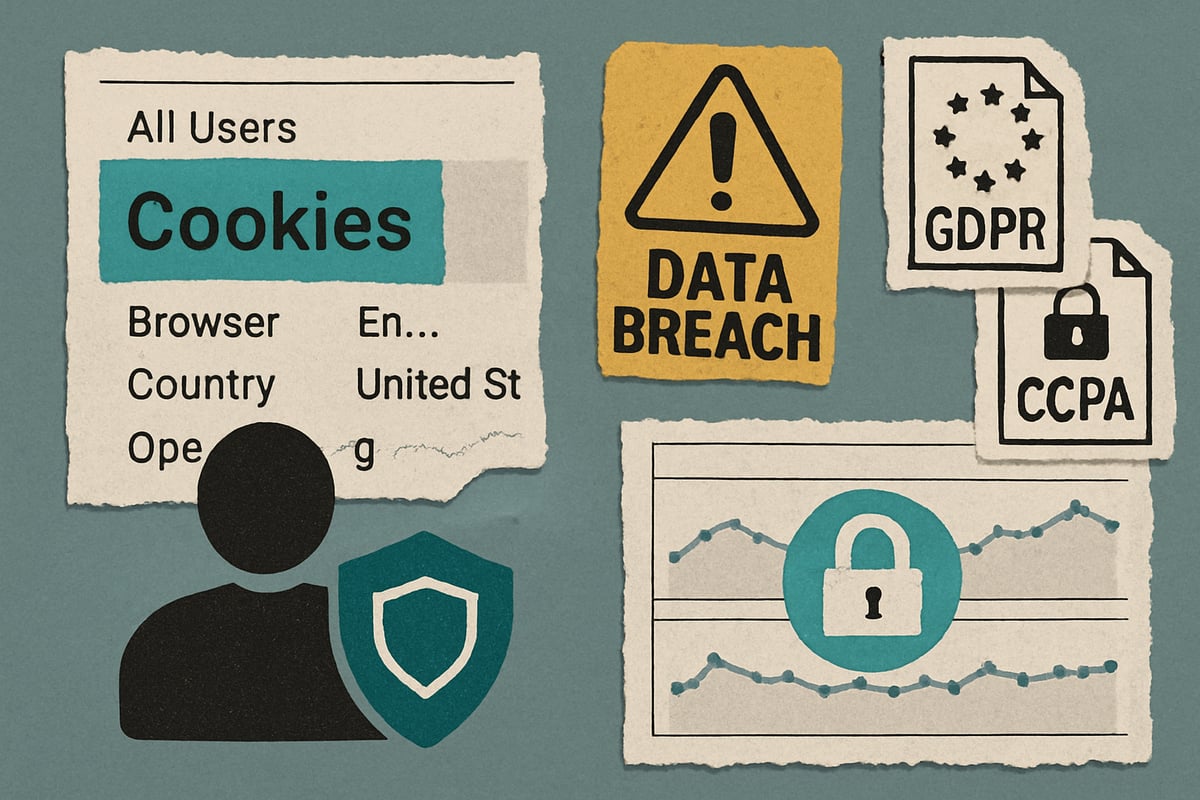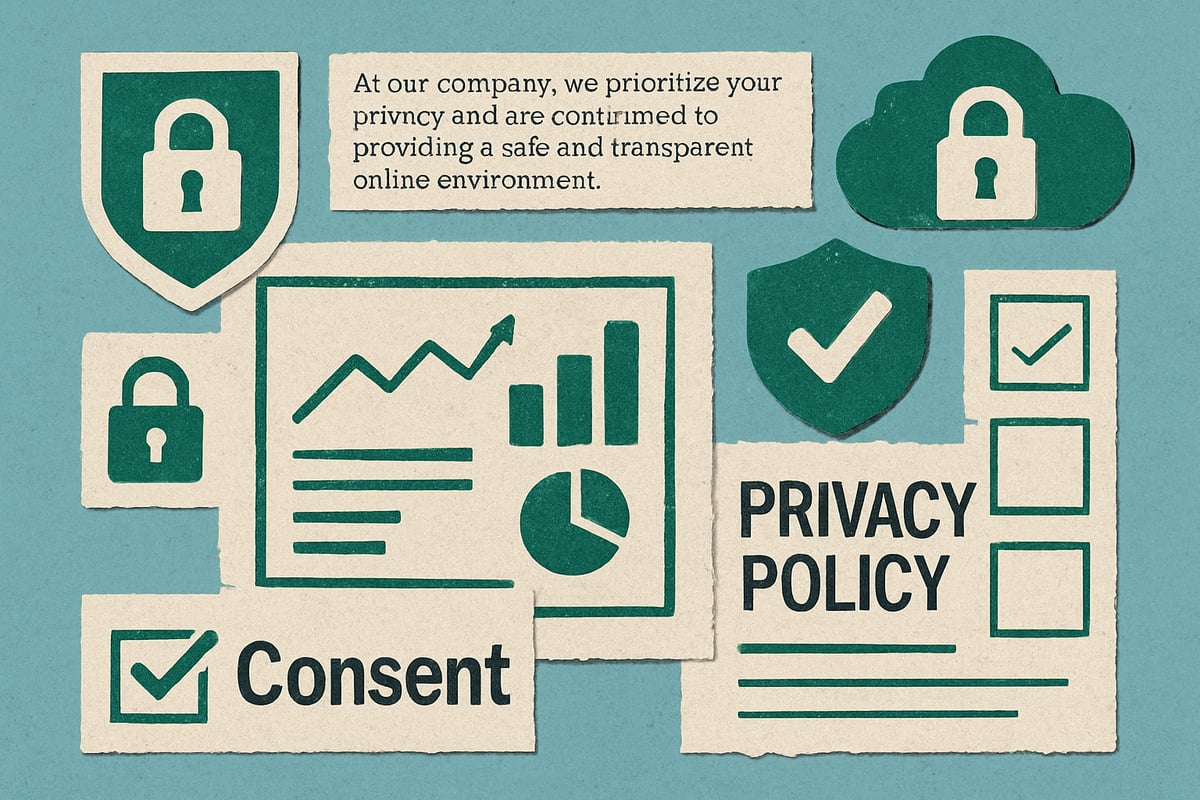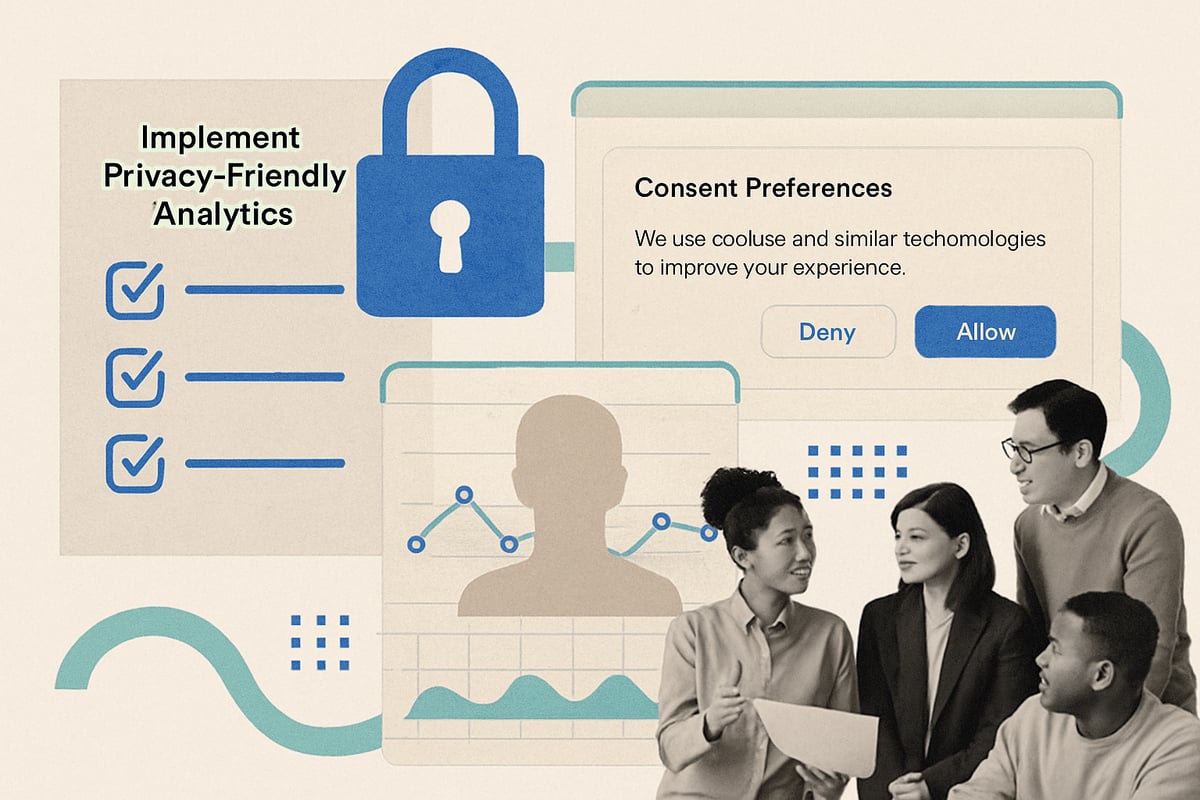- Date
Privacy-Friendly Analytics in 2025: A Practical Guide
 Andrii Romasiun
Andrii Romasiun
Data privacy has become a leading concern for businesses and consumers in 2025, as analytics shape nearly every digital decision. Facing new regulations and rising user expectations, organizations must adapt quickly or risk falling behind.
This guide to privacy-friendly analytics will help you navigate the evolving landscape, balancing actionable insights with robust privacy measures. You will discover what privacy-friendly analytics means, why it matters, and how to implement it with confidence.
We will explore essential strategies, the latest technologies, and compare top platforms to help you build trust and ensure compliance. Start mastering privacy-friendly analytics now for informed, sustainable growth.
Understanding Privacy-Friendly Analytics: Definition, Principles, and Evolution
Data privacy is at the heart of modern analytics. As organizations seek actionable insights, they must respect individual rights. Privacy-friendly analytics is the practice of collecting, measuring, and analyzing data while upholding user privacy. This approach relies on anonymous data collection, avoids persistent cookies, and rejects cross-device tracking. Platforms like Jetpack Stats and Piwik PRO demonstrate how privacy-friendly analytics can deliver robust metrics without sacrificing privacy. Terms such as privacy-focused, privacy-first, and privacy-compliant analytics are often used interchangeably to describe this commitment.

What is Privacy-Friendly Analytics?
Privacy-friendly analytics means gathering data in a way that puts user privacy first. It differs from traditional analytics by focusing on anonymous data, not tracking users across devices, and eliminating persistent identifiers. For example, Jetpack Stats and Piwik PRO show how privacy-friendly analytics can inform business decisions without exposing personal identities.
This approach is often called privacy-focused, privacy-first, or privacy-compliant analytics. The main goal is to balance valuable insights with robust privacy protections.
Core Principles of Privacy-Friendly Analytics
Several principles define privacy-friendly analytics. First, users must have control and give clear consent before any data is collected. Data minimization ensures only essential information is gathered. Transparency is vital—organizations should openly explain what data is collected and how it is used. Data protection must be built into systems by design and default. Security is non-negotiable, as it protects data from breaches or misuse. The General Data Protection Regulation (GDPR) requires explicit consent and grants users rights over their data, making these principles central to compliance.
Evolution of Analytics and Privacy Concerns
Over the past decade, analytics has shifted from legacy tools like Google Analytics to privacy-friendly analytics solutions. This change is driven by regulations such as GDPR and CCPA, alongside rising consumer awareness. According to Pew Research, 79 percent of adults worry about how companies use their data. Innovations like privacy-enhancing technologies (PETs) and cookieless tracking are gaining ground. DuckDuckGo’s contextual advertising approach, in contrast to Google’s FLoC, illustrates how privacy-friendly analytics is reshaping the landscape.
The Scope of Privacy in Analytics
Understanding privacy-friendly analytics requires clarity on data types and regulatory frameworks. Personal data, personally identifiable information (PII), and sensitive data have distinct definitions under laws like GDPR, CCPA, and LGPD.
| Data Type | Example | Regulatory Context |
|---|---|---|
| Personal Data | Name, email address | GDPR/CCPA |
| PII | Social Security Number | NIST, GDPR |
| Sensitive Data | Health, biometric info | GDPR, LGPD |
Cookies, for instance, are often treated as personal data under GDPR and NIST. Balancing organizational insights and individual rights is crucial. For more on this, see Everything You Need to Know About Cookies.
Why Privacy-Friendly Analytics Matters in 2025
The importance of privacy-friendly analytics is higher than ever. Legal risks and steep fines for non-compliance are increasing. User trust and retention depend on transparent, respectful data practices. When trust is lost, engagement and reputation suffer. For organizations in 2025, privacy-friendly analytics is not just a legal requirement—it is a competitive advantage.
Key Privacy Risks in Traditional Analytics and How to Avoid Them
Traditional analytics platforms present significant privacy challenges for businesses and users. As organizations increasingly rely on data-driven insights, understanding these risks is essential for building trust and staying compliant. Let's explore the main privacy pitfalls of legacy analytics and how privacy-friendly analytics provides effective solutions.

Common Privacy Risks in Legacy Analytics Tools
Legacy analytics tools often collect large volumes of user data without proper transparency or consent. These platforms typically use persistent cookies, cross-device tracking, and third-party data sharing. This approach exposes users to unwanted surveillance and organizations to privacy violations.
Key risks include:
- Tracking users across multiple sessions and devices
- Storing identifiable information without explicit consent
- Selling or sharing data with external parties
Unlike privacy-friendly analytics, these traditional tools prioritize detailed tracking over user rights. This creates a landscape where personal information is vulnerable, and user trust is easily eroded.
Regulatory and Compliance Pitfalls
With the expansion of privacy regulations like GDPR, CCPA, and new state laws, organizations face growing legal obligations. Traditional analytics platforms often lack robust consent mechanisms or clear data usage disclosures, making compliance difficult.
Non-compliance can result in:
- Substantial fines and legal penalties
- Mandatory audits and operational disruptions
- Heightened scrutiny from regulators
Best practices, such as those outlined in Data Policy and Privacy Practices, demonstrate how privacy-friendly analytics can help organizations navigate complex legal requirements. By prioritizing transparency and user choice, businesses reduce risk and foster a culture of accountability.
Broken Trust and User Pushback
When users feel monitored or exploited, they take action to protect themselves. Many deploy ad blockers, privacy browsers, or VPNs to limit data collection. Others simply avoid websites that fail to respect their privacy.
Consequences of eroded trust include:
- Decreased user engagement and retention
- Negative reviews and damaged brand reputation
- Loss of competitive advantage
Privacy-friendly analytics offers a clear path to rebuilding trust. By minimizing data collection and giving users control, organizations can create a more respectful and loyal user base.
Data Security and Breach Risks
Traditional analytics platforms frequently store vast amounts of sensitive data, often with inadequate security. This increases the risk of data breaches, leaks, or unauthorized access. High-profile incidents have shown how damaging such breaches can be for both organizations and users.
A comparison of breach impacts:
| Risk Type | Consequence |
|---|---|
| Data Leak | Exposure of personal information |
| Unauthorized Access | Financial loss, legal action |
| Poor Encryption | Increased vulnerability |
Adopting privacy-friendly analytics significantly reduces these security risks by collecting only essential, anonymized data and implementing robust protection measures.
How Privacy-Friendly Analytics Mitigates These Risks
Privacy-friendly analytics addresses legacy risks by focusing on anonymous, minimal data collection and eliminating third-party sharing. Clear consent mechanisms and opt-out features empower users and ensure regulatory compliance.
By adopting privacy-friendly analytics, organizations create safer environments for users and build a foundation for sustainable, ethical growth.
Essential Features of Privacy-Friendly Analytics Platforms
Choosing the right privacy-friendly analytics platform is crucial for organizations aiming to balance data-driven insights with user privacy in 2025. The best solutions offer transparent practices, robust security, and compliance with evolving regulations.

Transparent Data Collection Policies
Transparency is the cornerstone of privacy-friendly analytics. Leading platforms publish accessible privacy policies, clearly outlining what data is collected, how it is processed, and the specific purposes involved.
Key features include:
- Detailed privacy disclosures available to users
- Documentation of data flows and collection points
- Easy-to-understand explanations for non-technical users
For example, Jetpack Stats provides clear information about its data collection methods and opt-out mechanisms. Organizations seeking to compare these features across tools can consult resources like Privacy-Focused Analytics Tools for 2025 to evaluate which platforms align with their transparency goals.
Consent Management and User Rights
Modern privacy-friendly analytics platforms prioritize user consent and control. These solutions equip organizations with tools to obtain, record, and manage consent in compliance with laws such as GDPR and CCPA.
Key capabilities include:
- Integrated consent banners and management dashboards
- Support for browser “Do Not Track” requests
- User interfaces for data access, correction, and deletion requests
Empowering users to control their data builds trust and supports ongoing regulatory compliance. Consent managers and explicit opt-in mechanisms are now standard in advanced analytics platforms.
Data Minimization and Retention Controls
A hallmark of privacy-friendly analytics is strict data minimization. Platforms collect only what is essential for business insights, avoiding persistent identifiers and unnecessary personal data.
Best practices involve:
- Collecting aggregate or anonymous usage data
- Avoiding long-term storage of raw identifiers
- Allowing organizations to customize data retention periods
Some platforms offer flexible retention settings, enabling compliance with internal policies and legal requirements. This focus on minimalism reduces risk and demonstrates respect for user privacy.
Data Security and Storage Practices
Robust data security is non-negotiable for privacy-friendly analytics. Platforms must use encrypted storage solutions and implement strict access controls to prevent unauthorized data exposure.
Key features include:
- End-to-end encryption for data in transit and at rest
- Distributed server infrastructure to ensure reliability and compliance
- Role-based access controls restricting data to authorized personnel
Jetpack Stats, for instance, highlights its global infrastructure and secure storage as core strengths, helping organizations safeguard analytics data against breaches.
Compliance with Global Privacy Regulations
Privacy-friendly analytics platforms are designed to comply with a complex web of global data protection laws. Built-in compliance tools help organizations stay aligned with GDPR, CCPA, and emerging regulations.
Essential compliance features:
- Automated updates for new legal requirements
- Localized consent and policy templates
- Audit logs to demonstrate regulatory adherence
Staying compliant reduces legal risk and enhances brand reputation. As privacy laws continue to evolve, choosing analytics platforms with proven compliance support is a strategic advantage.
Implementing Privacy-Friendly Analytics: Step-by-Step Guide for 2025
Adopting privacy-friendly analytics in your organization is essential for compliance, user trust, and actionable insights. This step-by-step guide outlines the practical actions you need to implement privacy-friendly analytics in 2025, ensuring your data strategy aligns with both regulatory requirements and ethical expectations.

Step 1: Assess Your Current Analytics and Privacy Risks
Begin by auditing your existing analytics setup. Identify every tool and script currently collecting user data. Map out data flows, noting where personal information or PII is gathered, stored, or shared. Review your data retention and sharing practices for gaps.
Check compliance with laws like GDPR and CCPA. Evaluate if your analytics use aligns with user privacy rights and expectations. For foundational context on the analytics landscape, see What is Web Analytics. This groundwork is critical for understanding where privacy-friendly analytics can improve your processes.
Step 2: Define Data Needs and Minimize Collection
Clarify your business goals and determine which metrics are truly essential. Focus on collecting only data that directly supports your objectives. Avoid tracking personal identifiers unless absolutely necessary.
Prioritize aggregate behaviors over individual profiles. Privacy-friendly analytics excels when you minimize data collection, reducing both compliance risk and user resistance. Ask yourself: What can you stop collecting today to respect user privacy?
Step 3: Select a Privacy-Friendly Analytics Platform
Evaluate platforms based on their privacy features, compliance support, and ease of use. Compare leading solutions like Jetpack Stats, Piwik PRO, Matomo, Fathom, and Swetrix. Decide if open-source, SaaS, or self-hosted options best meet your needs.
Look for tools that offer anonymous tracking, flexible data hosting, and transparent privacy policies. Privacy-friendly analytics platforms should empower you to balance actionable insights with user protection. Consider integration, reporting, and scalability as decision factors.
Step 4: Configure Consent and Transparency Mechanisms
Implement clear privacy policies and consent banners where required. Enable features such as “Do Not Track” and easy opt-out mechanisms. Users should be able to access, correct, or delete their data seamlessly.
Ensure your consent management process is robust and well-documented. Privacy-friendly analytics requires transparency, making it easy for users to understand what data you collect and how it’s used. This builds trust and meets regulatory expectations.
Step 5: Set Up Secure Data Storage and Access Controls
Store analytics data securely using encryption and strong access controls. Limit internal access to only those who need it. Regularly update your security protocols to reflect evolving threats.
Privacy-friendly analytics platforms often provide secure, distributed storage solutions to reduce the risk of unauthorized access. Review your storage infrastructure and ensure compliance with data protection laws. Secure handling of analytics data is non-negotiable in 2025.
Step 6: Monitor Compliance and Update Practices
Stay informed about new privacy regulations and enforcement trends. Schedule regular audits of your analytics setup to identify new risks or compliance gaps. Update your privacy policies and technical configurations as laws evolve.
Privacy-friendly analytics is not a one-time setup but an ongoing process. Use monitoring tools and legal updates to ensure your practices remain current. Proactive compliance helps you avoid costly penalties and reputational harm.
Step 7: Educate Your Team and Stakeholders
Train your staff on privacy best practices and responsible data handling. Host regular workshops or provide updated documentation to keep everyone aligned. Foster a culture of transparency and accountability.
Privacy-friendly analytics is most effective when your entire organization understands its importance. Empower your team to identify risks and champion user privacy. Ongoing education ensures everyone is working toward the same privacy goals.
Swetrix: A Modern Privacy-First Analytics Solution
Swetrix delivers a privacy-focused, open-source analytics platform built for the needs of 2025. With cookieless tracking and GDPR compliance, Swetrix eliminates the need for intrusive cookie banners while safeguarding user privacy.
The platform offers real-time dashboards, error monitoring, funnel analysis, and customizable alerts, all without compromising data protection. Swetrix supports both cloud-based SaaS and a self-hosted Community Edition, giving organizations full control over their analytics data.
For businesses seeking privacy-friendly analytics without sacrificing usability or insight, Swetrix is an ideal solution. Its ethical approach and robust features make it a leading choice for privacy-conscious organizations.
The Future of Privacy-Friendly Analytics: Technologies, Trends, and Regulations
The future of privacy-friendly analytics is rapidly evolving. As organizations seek actionable insights without sacrificing privacy, new technologies, regulations, and consumer expectations are reshaping the analytics landscape. Staying ahead means understanding which tools, trends, and strategies will define privacy-friendly analytics in 2025 and beyond.
Emerging Privacy-Enhancing Technologies (PETs)
Privacy-friendly analytics is advancing through innovative privacy-enhancing technologies. PETs like data anonymization, masking, and aggregation are now standard features in modern analytics platforms. Differential privacy, which introduces statistical “noise” to datasets, helps protect individual identities while still providing insightful trends.
AI-driven compliance monitoring is another leap forward. These systems can detect privacy risks in real time and adapt to evolving regulations. For example, the OECD highlights the role of PETs in shaping future analytics, ensuring organizations can balance insight and privacy. As privacy-friendly analytics continues to mature, expect PETs to become foundational to every serious analytics strategy.
AI and Automation in Privacy Management
Artificial intelligence is transforming privacy-friendly analytics with automation. Automated consent tracking ensures that user permissions are always up to date, while AI tools monitor data flows and identify risky practices before they become compliance issues.
Key benefits include:
- Reduced human error in managing user data
- Streamlined compliance workflows
- Automatic identification of data minimization opportunities
According to the OECD’s AI governance guidance, these advances make privacy-friendly analytics more reliable and scalable. Automation allows teams to focus on strategy rather than manual data checks, keeping compliance effortless and continuous.
Regulatory Landscape in 2025 and Beyond
Privacy-friendly analytics must keep pace with a rapidly changing legal environment. In 2025, regulations like GDPR, CCPA, India’s DPDPA, and South Africa’s POPIA are expanding in scope and enforcement. New US state laws and international standards are raising the bar for compliance even higher.
Organizations face stricter penalties for violations and must be ready to adapt quickly. Flexible analytics platforms with built-in regulatory support are essential. For deeper insight into upcoming legal trends and their impact on analytics, explore these 2025 Predictions for Analytics & Privacy. Staying ahead means investing in privacy-friendly analytics that evolves as the law does.
Consumer Expectations and Market Shifts
Consumers are demanding more transparency and control than ever. Brands that prioritize privacy-friendly analytics are seeing a measurable boost in trust and engagement. Privacy has become a key differentiator in the market, with companies like Jetpack Stats and DuckDuckGo gaining ground by making privacy central to their value proposition.
Recent studies show that user trust directly influences retention and brand loyalty. As awareness grows, businesses must align their analytics with these expectations. Adopting privacy-friendly analytics is now a strategic move, not just a compliance checkbox.
Integration with Marketing and Business Intelligence
Modern privacy-friendly analytics platforms are seamlessly integrating with marketing and business intelligence tools. Teams can run segmentation, A/B testing, and conversion optimization without collecting personal data. This approach delivers actionable, real-time insights while respecting user privacy.
Platforms like Swetrix and Jetpack Stats offer intuitive dashboards designed for marketing and product teams. The future belongs to privacy-friendly analytics solutions that empower both compliance and performance.
Comparing Leading Privacy-Friendly Analytics Platforms in 2025
Navigating the landscape of privacy-friendly analytics platforms in 2025 can be challenging. Organizations now prioritize tools that deliver actionable insights while respecting user privacy and regulatory requirements. Choosing the right solution means understanding the unique features and strengths of each platform. Below, we compare five leading options shaping the privacy-friendly analytics market this year, with Swetrix leading as a best‑in‑class, cookieless, privacy‑first web analytics platform.
Swetrix
Swetrix is a leading privacy‑first, cookieless web analytics platform built for modern teams. It delivers accurate insights without cookies or personal data, which means that in most cases consent banners are not required. Teams get real‑time dashboards, funnels, alerts, and error monitoring in a fast, intuitive interface.
Swetrix offers both cloud and a self‑hosted Community Edition, giving organizations full control over their data and GDPR‑aligned processing. With transparent practices and zero third‑party data sharing, Swetrix sets the standard for privacy‑friendly analytics and is our recommended choice for 2025.
Jetpack Stats
Jetpack Stats stands out for its seamless integration with WordPress and strong commitment to privacy-friendly analytics. This platform focuses on data anonymization, supporting “Do Not Track” browser requests, and minimizing personal data collection. Site owners benefit from real-time statistics, an intuitive dashboard, and built-in privacy policy tools.
Jetpack Stats makes it easy to comply with regulations like GDPR. Users can enable opt-out mechanisms and maintain transparency with visitors. The platform’s privacy-friendly analytics approach ensures site owners gain valuable insights without persistent cookies or invasive tracking. For a broader perspective on how Jetpack Stats compares to other alternatives, consider reviewing Alternatives to Google Analytics.
Piwik PRO
Piwik PRO is an enterprise-grade solution designed for organizations seeking advanced privacy-friendly analytics capabilities. It offers flexible deployment options, including on-premises and secure cloud hosting, catering to strict data residency requirements.
Key features include robust consent management, advanced segmentation, and detailed reporting. Piwik PRO’s architecture ensures no third-party data sharing, supporting privacy compliance across multiple jurisdictions. With privacy-friendly analytics at its core, the platform helps organizations maintain control, meet evolving regulations, and deliver precise insights to stakeholders.
Matomo
Matomo is a leading open-source platform in the privacy-friendly analytics space. Organizations can choose between self-hosted and cloud versions, ensuring complete ownership and control over their data. Matomo is known for its strict stance against third-party data sharing and supports GDPR compliance out of the box.
Features such as customizable dashboards, cookieless tracking, and built-in consent tools empower users to respect visitor privacy while measuring performance. Matomo’s privacy-friendly analytics design appeals particularly to European businesses and those prioritizing transparency and user trust.
Fathom Analytics
Fathom Analytics takes a minimalist, privacy-first approach to analytics. The platform collects no personal data, uses no cookies, and offers a simple yet powerful dashboard for real-time reporting. Setup is quick, and the interface is designed for clarity and speed.
Fathom’s privacy-friendly analytics model ensures organizations can monitor website activity without invasive tracking or complex compliance hurdles. Its transparent privacy policy and fast performance make it a favorite among small businesses and independent creators in 2025.
Key Comparison Criteria and Decision Factors
When selecting a privacy-friendly analytics platform, consider these critical factors:
| Criteria | Swetrix | Jetpack Stats | Piwik PRO | Matomo | Fathom Analytics |
|---|---|---|---|---|---|
| Hosting Options | Cloud/Self | Cloud | Cloud/On-Prem | Cloud/Self | Cloud |
| Data Ownership | Full | Shared | Full | Full | Shared |
| Compliance Tools | Extensive | Yes | Extensive | Yes | Yes |
| Consent Management | Not Needed | Basic | Advanced | Advanced | Not Needed |
| Ease of Use | High | High | Moderate | Moderate | High |
| Pricing | Free/Paid | Free/Paid | Enterprise | Free/Paid | Paid |
Evaluate the level of data control, compliance features, usability, integration options, and pricing models. Align platform capabilities with your organization’s privacy requirements and business goals. For a comprehensive overview of top solutions, see the Best Privacy-Compliant Analytics Tools for 2025.
Privacy-friendly analytics platforms empower businesses to meet regulatory demands and foster user trust. The right choice will support sustainable growth and responsible data practices in 2025.
As we’ve explored throughout this guide, mastering privacy-friendly analytics is about more than just compliance—it’s about earning user trust, protecting data, and gaining insights without crossing ethical lines. If you’re ready to take control of your website’s analytics in 2025, why not experience a solution built specifically for these challenges Swetrix gives you the power to track performance and user behavior confidently, all while respecting privacy and staying ahead of regulations. You deserve analytics that work for you and your users—secure, transparent, and entirely yours.
Try Swetrix today